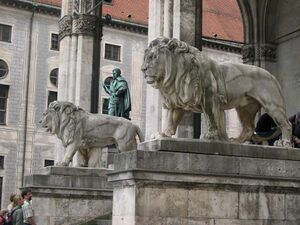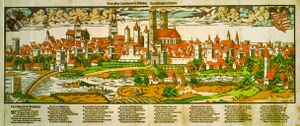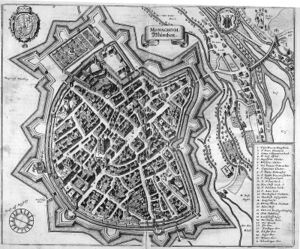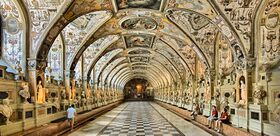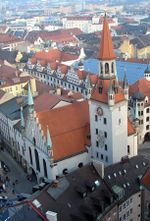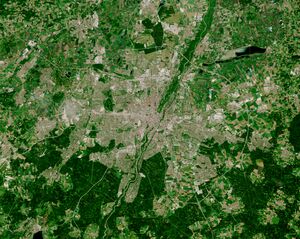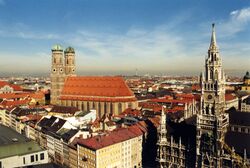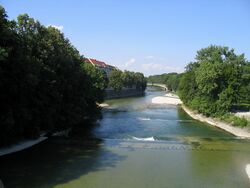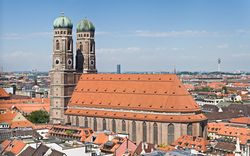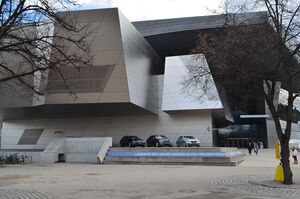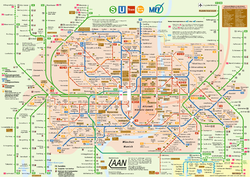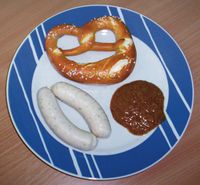ميونخ
ميونخ (Munich ؛ /ˈmjuːnɪk/ MEW-nik; ألمانية: München [ˈmʏnçn̩] (![]() listen); باڤارية: Minga [ˈmɪŋ(ː)ɐ](
listen); باڤارية: Minga [ˈmɪŋ(ː)ɐ](![]() استمع)) هي ثالث أكبر مدن ألمانيا و عاصمة ولاية باڤاريا. تقع المدينة في جنوب ألمانيا على نهر إيزار على بعد حوالي ساعة بالسيارة من جبال الألب. تدعى أحيانا بالعاصمة الخفية لألمانيا. يبلغ عدد سكانها حوالي 1,578,132 نسمة (في 31 مايو 2022). city's metropolitan region is home to about 6 million people.[3] موقعها المميز في وسط أوروبا، جعلها عبر التاريخ محطة و مركز مهم في القارة. اليوم تشكل ميونخ باقتصادها، إحدى أغنى مدن ألمانيا وأقواها اقتصادا. بها مقر عدد من الشركات والمصانع الألمانية المهمة، أهمها شركة السيارات بي إم في (BMW)، شركة التأمين أليانز، شركة سيمنز للكهربائيات والاتصالات وشركة مان لصناعة المركبات الثقيلة. هي أيضا مركز مهم للموضة والثقافة والأدب في ألمانيا، حيث بها مقر عدد من محطات التلفزة والإذاعة و حوالي 300 دار نشر. يزورها سنويا حوالي ثلاثة ملايين سائح. حسب الإحصاءات الألمانية، فإن ميونخ تعد المدينة المفضلة الأولى للمعيشة في ألمانيا. أقيمت بها عام 1972 الألعاب الأوليمبية.
استمع)) هي ثالث أكبر مدن ألمانيا و عاصمة ولاية باڤاريا. تقع المدينة في جنوب ألمانيا على نهر إيزار على بعد حوالي ساعة بالسيارة من جبال الألب. تدعى أحيانا بالعاصمة الخفية لألمانيا. يبلغ عدد سكانها حوالي 1,578,132 نسمة (في 31 مايو 2022). city's metropolitan region is home to about 6 million people.[3] موقعها المميز في وسط أوروبا، جعلها عبر التاريخ محطة و مركز مهم في القارة. اليوم تشكل ميونخ باقتصادها، إحدى أغنى مدن ألمانيا وأقواها اقتصادا. بها مقر عدد من الشركات والمصانع الألمانية المهمة، أهمها شركة السيارات بي إم في (BMW)، شركة التأمين أليانز، شركة سيمنز للكهربائيات والاتصالات وشركة مان لصناعة المركبات الثقيلة. هي أيضا مركز مهم للموضة والثقافة والأدب في ألمانيا، حيث بها مقر عدد من محطات التلفزة والإذاعة و حوالي 300 دار نشر. يزورها سنويا حوالي ثلاثة ملايين سائح. حسب الإحصاءات الألمانية، فإن ميونخ تعد المدينة المفضلة الأولى للمعيشة في ألمانيا. أقيمت بها عام 1972 الألعاب الأوليمبية.
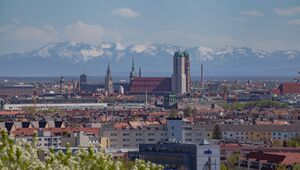
Straddling the banks of the River Isar north of the Alps, Munich is the seat of the Bavarian administrative region of Upper Bavaria, while being the most densely populated municipality in Germany with 4,500 people per km2. Munich is the second-largest city in the Bavarian dialect area, after the Austrian capital of Vienna.
The city was first mentioned in 1158. Catholic Munich strongly resisted the Reformation and was a political point of divergence during the resulting Thirty Years' War, but remained physically untouched despite an occupation by the Protestant Swedes.[4] Once Bavaria was established as Kingdom of Bavaria in 1806, Munich became a major European centre of arts, architecture, culture and science. In 1918, during the German Revolution of 1918–19, the ruling House of Wittelsbach, which had governed Bavaria since 1180, was forced to abdicate in Munich and a short-lived Bavarian Soviet Republic was declared. In the 1920s, Munich became home to several political factions, among them the Nazi Party. After the Nazis' rise to power, Munich was declared their "Capital of the Movement". The city was heavily bombed during World War II, but has restored most of its old town. After the end of postwar American occupation in 1949, there was a great increase in population and economic power during the years of Wirtschaftswunder. The city hosted the 1972 Summer Olympics.
Today, Munich is a global centre of science, technology, finance, innovation, business, and tourism. Munich enjoys a very high standard and quality of living, reaching first in Germany and third worldwide according to the 2018 Mercer survey,[5] and being rated the world's most liveable city by the Monocle's Quality of Life Survey 2018.[6] Munich is consistently ranked as one of the most expensive cities in Germany in terms of real estate prices and rental costs.[7][8]
In 2021, 28.8 percent of Munich's residents were foreigners, and another 17.7 percent were German citizens with a migration background from a foreign country.[9] Munich's economy is based on high tech, automobiles, and the service sector, as well as IT, biotechnology, engineering, and electronics. It has one of the strongest economies of any German city and the lowest unemployment rate of all cities in Germany with more than 1 million inhabitants. The city houses many multinational companies, such as BMW, Siemens, MAN SE, Allianz SE and Munich Re. In addition, Munich is home to two research universities, and a multitude of scientific institutions.[10] Munich's numerous architectural and cultural attractions, sports events, exhibitions and its annual Oktoberfest, the world's largest Volksfest, attract considerable tourism.[11]
التاريخ
أصل الاسم
Munich was a tiny 8th century friar settlement, which was named zu den Munichen (to the Monks). The Old High German Muniche served as basis for the modern German city name München.[12]
قبل التاريخ
The river Isar was a prehistoric trade route and in the Bronze Age Munich was among the largest raft ports in Europe.[13] Bronze Age settlements, up to 4000 years old, have been discovered.[14] Evidence of Celt settlements from the Iron Age have been discovered in areas around Ramersdorf-Perlach.[15]
العصر الروماني
The ancient Roman road Via Julia, which connected Augsburg and Salzburg, crossed over the Isar river south of Munich, at the towns of Baierbrunn and Gauting.[16] A Roman settlement north-east of Munich was excavated in the neighborhood of Denning.[17]
مستوطنات ما بعد الرومان
Starting in the 6th century, the Baiuvarii populated the area around what is now modern Munich, such as in Johanneskirchen, Feldmoching, Bogenhausen and Pasing.[18][19] The first known Christian church was built ca. 815 in Fröttmanning.[20]
أصل البلدة القروسطية
تأسست المدينة إلى جانب مستوطنة الكاهن مونيشن (باللاتينية Monacum, Monachium) على يد هنري الملقب بهنري الأسد، من أسرة گـِلف، دوق ساكسونيا وبافاريا. نمت القرية إلى جانب كنيسة القديس بطرس الحالية بجانب جسر، الذي بناه هنري على نهر إيزار. لإجبار التجار على استخدام الجسر واقتطاع مبلغ معين لقاء ذلك، قام هنري بتدمير جسر قريب تعود ملكيته لاوتو من فريزنگ. نشأ بعدها صراع على سلطة ميونخ، بعد تدخل الإمبراطور فريدريش الأول بارباروسا، تم حل النزاع وظهرت بعدها ميونخ كبلدة تجارة مهمة في المنطقة. بعد حوالي عقدين من الزمن حصلت ميونخ على صفة المدينة وتم تحصينها. أصبحت عام 1255 مقر عدة أمراء وفي عام 1314 اتخذها الملك لودڤيگ الرابع مقراً له، توج عام 1328 ليصبح قيصرا. أدخل تحسينات عدة على ميونخ ونمت في عهده بسرعة.
عاصمة باڤاريا المعاد توحيدها
When Bavaria was reunited in 1506 after a brief war against the Duchy of Landshut, Munich became its capital. The arts and politics became increasingly influenced by the court.[بحاجة لمصدر] The Renaissance movement beset Munich and the Bavarian branch of the House of Wittelsbach under the Duke of Bavaria Albrecht V bolstered their prestige by conjuring up a lineage that reached back to Classical antiquity. In 1568 Albrecht V built the Antiquarium to house the Wittelsbach collection of Greek and Roman antiquities in the Munich Residenz.[21] Albrecht V appointed the composer Orlando di Lasso as director of the court orchestra and tempted numerous Italian musicians to work at the Munich court, establishing Munich as a hub for late Renaissance music.[22] During the rule of Duke William V Munich began to be called the "German Rome" and William V began presenting Emperor Charlemagne as ancestor of the Wittelsbach dynasty.[23]
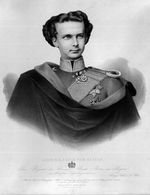
أصبحت ميونخ عاصمة بافاريا عام 1506. في العقود اللاحقة صارت ميونخ مركزا مهما لعصر النهضة ومركزا لمناهضة الإصلاح الديني في ألمانيا الذي بدأه مارتن لوثر.
الرابطة الكاثوليكية تأسست في ميونخ عام 1609. وفي عام 1623، في خضم حرب الثلاثين سنة أصبحت ميونخ مقراً انتخابياً عندما مـُنـِح ماكسمليان الأول، دوق باڤاريا لقب أمير-ناخب ولكن في 1632 المدينة احتلها گوستاڤ الثاني أدولف من السويد. أثر ذلك، ومعه وباء الطاعون الذي انتشر في المدينة لاحقا، على النمو السكاني في المدينة، حيث خسرت في هذه الفترة ثلث سكانها. بعد نهاية حرب الثلاثين عاما 1648، تعافت ميونخ بسرعة وبدأ طابع البناء الباروك الإيطالي بالانتشار فيها. بعد تحالف القيصر ماكسيميليان الثاني مع فرنسا، احتلت القوات الإسبانية المدينة 1704 لعدة سنوات تحت حكم آل هابسبورگ.
نمت المدينة سكانيا بشكل كبير منذ نهاية القرن الثامن عشر، حيث لوحظ تضاعف عدد السكان كل 30 عام. كان عدد سكانها على سبيل المثال عام 1701 حوالي 24,000، في 1871 170,000 نسمة، في 1933 840,000 نسمة.
باني ميونخ الحقيقي كان الملك لودڤيگ الثاني، الذي حكم ما بين 1825 إلى 1848. جعل من المدينة مركزا تجاريا وثقافيا مهما في أوروبا.
بعد نهاية الحرب العالمية الاولى عاشت ميونخ أحد أسوأ فتراتها على مر العصور، حيث انتشر الدمار والسرقة والفقر والجوع والبطالة، مما مهد الطريق لبزوغ نجم الفكر اليميني المتشدد الذي عرف فيما بعد بالفكر النازي. قاد الزعيم اليميني أدولف هتلر المسيرة النازية الشهيرة عام 1923 إلى صالة رجال الساحة (هيرنفيلد هاله) في قلب ميونخ، حاول من خلالها عمل ثورة شعبية ضد الدولة ولكنه فشل. بعد عشرة سنوات، تسلم هتلر المستشارية في ألمانيا بطريقة ديمقراطية. أعلن هتلر مدينة ميونخ عام 1935 "كعاصمة الحركة". دمرت أجزاء كبيرة من المدينة خلال الحرب العالمية الثانية، ولكن في فترة الخمسينيات والستينيات أعيد إعمار ميونخ ونمت بسرعة لتصبح مدينة يفوق عدد سكانها المليون نسمة. أقيمت فيها الألعاب الأوليمبية الصيفية عام 1972 وكانت أحد مدن كأس العالم لكرة القدم التي أقيمت في ألمانيا عام 1974. أقيمت فيها مباراة افتتاح كأس العالم لكرة القدم 2006 بين منتخبي ألمانيا وكوستاريكا.
الجغرافيا
الطبوغرافيا
Munich lies on the elevated plains of Upper Bavaria, about 50 km (31 mi) north of the northern edge of the Alps, at an altitude of about 520 m (1،706 ft) ASL. The local rivers are the Isar and the Würm. Munich is situated in the Northern Alpine Foreland. The northern part of this sandy plateau includes a highly fertile flint area which is no longer affected by the folding processes found in the Alps, while the southern part is covered with morainic hills. Between these are fields of fluvio-glacial out-wash, such as around Munich. Wherever these deposits get thinner, the ground water can permeate the gravel surface and flood the area, leading to marshes as in the north of Munich.
المناخ
Munich is located in close proximity of the Alps. Munich has an oceanic climate (Cfb) under the Köppen climate classification. Annual variation in temperature can be significant, as there is no substantial bodies of water nearby. The winter in Munich can be cold and overcast, while some Munich winters can be marked by snow and frost. In Munich, January is the coldest month, night time temperature can be as low as −5 Celsius and even lower. In Munich the summer is usually pleasantly warm, with temperatures averaging 23 Celsius. But, Munich summers can average up to 28 Celsius, topping 30 Celsius on average. During extreme heat summers in Munich, rain and thunderstorms are normal.[24]
| بيانات المناخ لـ Munich (Dreimühlenviertel), elevation: 515 m and 535 m, 1981–2010 normals, extremes 1954–present[أ] | |||||||||||||
|---|---|---|---|---|---|---|---|---|---|---|---|---|---|
| الشهر | ينا | فب | مار | أبر | ماي | يون | يول | أغس | سبت | أكت | نوف | ديس | السنة |
| القصوى القياسية °س (°ف) | 18.9 (66.0) |
21.4 (70.5) |
24.0 (75.2) |
32.2 (90.0) |
31.8 (89.2) |
35.2 (95.4) |
37.5 (99.5) |
37.0 (98.6) |
31.8 (89.2) |
28.2 (82.8) |
24.2 (75.6) |
21.7 (71.1) |
37.5 (99.5) |
| متوسط القصوى اليومية °س (°ف) | 3.5 (38.3) |
5.0 (41.0) |
9.5 (49.1) |
14.2 (57.6) |
19.1 (66.4) |
21.9 (71.4) |
24.4 (75.9) |
23.9 (75.0) |
19.4 (66.9) |
14.3 (57.7) |
7.7 (45.9) |
4.2 (39.6) |
13.9 (57.0) |
| المتوسط اليومي °س (°ف) | 0.3 (32.5) |
1.4 (34.5) |
5.3 (41.5) |
9.4 (48.9) |
14.3 (57.7) |
17.2 (63.0) |
19.4 (66.9) |
18.9 (66.0) |
14.7 (58.5) |
10.1 (50.2) |
4.4 (39.9) |
1.3 (34.3) |
9.7 (49.5) |
| متوسط الدنيا اليومية °س (°ف) | −2.5 (27.5) |
−1.9 (28.6) |
1.6 (34.9) |
4.9 (40.8) |
9.4 (48.9) |
12.5 (54.5) |
14.5 (58.1) |
14.2 (57.6) |
10.5 (50.9) |
6.6 (43.9) |
1.7 (35.1) |
−1.2 (29.8) |
5.9 (42.6) |
| الصغرى القياسية °س (°ف) | −22.2 (−8.0) |
−25.4 (−13.7) |
−16.0 (3.2) |
−6.0 (21.2) |
−2.3 (27.9) |
1.0 (33.8) |
6.5 (43.7) |
4.8 (40.6) |
0.6 (33.1) |
−4.5 (23.9) |
−11.0 (12.2) |
−20.7 (−5.3) |
−25.4 (−13.7) |
| متوسط تساقط الأمطار mm (inches) | 48 (1.9) |
46 (1.8) |
65 (2.6) |
65 (2.6) |
101 (4.0) |
118 (4.6) |
122 (4.8) |
115 (4.5) |
75 (3.0) |
65 (2.6) |
61 (2.4) |
65 (2.6) |
944 (37.2) |
| Mean monthly ساعات سطوع الشمس | 79 | 96 | 133 | 170 | 209 | 210 | 238 | 220 | 163 | 125 | 75 | 59 | 1٬777 |
| Source 1: DWD[26] | |||||||||||||
| Source 2: SKlima.de[27] | |||||||||||||
Climate change
In Munich, the general trend of global warming with a rise of medium yearly temperatures of about 1 °C in Germany over the last 120 years can be observed as well. In November 2016 the city council concluded officially that a further rise in medium temperature, a higher number of heat extremes, a rise in the number of hot days and nights with temperatures higher than 20 °C (tropical nights), a change in precipitation patterns, as well as a rise in the number of local instances of heavy rain, is to be expected as part of the ongoing climate change. The city administration decided to support a joint study from its own Referat für Gesundheit und Umwelt (department for health and environmental issues) and the German Meteorological Service that will gather data on local weather. The data is supposed to be used to create a plan for action for adapting the city to better deal with climate change as well as an integrated action program for climate protection in Munich. With the help of those programs issues regarding spatial planning and settlement density, the development of buildings and green spaces as well as plans for functioning ventilation in a cityscape can be monitored and managed.[28]
السكان
| السنة | تعداد | ±% |
|---|---|---|
| 1500 | 13٬447 | — |
| 1600 | 21٬943 | +63.2% |
| 1750 | 32٬000 | +45.8% |
| 1880 | 230٬023 | +618.8% |
| 1890 | 349٬024 | +51.7% |
| 1900 | 499٬932 | +43.2% |
| 1910 | 596٬467 | +19.3% |
| 1920 | 666٬000 | +11.7% |
| 1930 | 728٬900 | +9.4% |
| 1940 | 834٬500 | +14.5% |
| 1950 | 823٬892 | −1.3% |
| 1955 | 929٬808 | +12.9% |
| 1960 | 1٬055٬457 | +13.5% |
| 1965 | 1٬214٬603 | +15.1% |
| 1970 | 1٬311٬978 | +8.0% |
| 1980 | 1٬298٬941 | −1.0% |
| 1990 | 1٬229٬026 | −5.4% |
| 2000 | 1٬210٬223 | −1.5% |
| 2005 | 1٬259٬584 | +4.1% |
| 2010 | 1٬353٬186 | +7.4% |
| 2011 | 1٬364٬920 | +0.9% |
| 2012 | 1٬388٬308 | +1.7% |
| 2013 | 1٬402٬455 | +1.0% |
| 2015 | 1٬450٬381 | +3.4% |
| 2018 | 1٬471٬508 | +1.5% |
| 2020 | 1٬488٬202 | +1.1% |
| 2022 | 1٬512٬491 | +1.6% |
| Population size may be affected by changes in administrative divisions. | ||
From only 24,000 inhabitants in 1700, the city population doubled about every 30 years. It was 100,000 in 1852, 250,000 in 1883 and 500,000 in 1901. Since then, Munich has become Germany's third-largest city. In 1933, 840,901 inhabitants were counted, and in 1957 over 1 million. Munich has reached 1.5 million in 2022.
Immigration
In July 2017, Munich had 1.42 million inhabitants; 421,832 foreign nationals resided in the city as of 31 December 2017 with 50.7% of these residents being citizens of EU member states, and 25.2% citizens in European states not in the EU (including Russia and Turkey).[29] Along with the Turks, the Croats are one of the two largest foreign minorities in the city, which is why some Croats refer to Munich as their "second capital."[30] The largest groups of foreign nationals were Turks (39,204), Croats (33,177), Italians (27,340), Greeks (27,117), Poles (27,945), Austrians (21,944), and Romanians (18,085).
| Country | Population |
|---|---|
| 39,745 | |
| 37,207 | |
| 28,496 | |
| 26,613 | |
| 21,559 | |
| 20,741 | |
| 18,845 | |
| 18,639 | |
| 17,833 | |
| 14,283 | |
| 13,636 | |
| 12,354 | |
| 11,228 | |
| 11,093 | |
| 10,650 | |
| 9,526 | |
| 9,414 | |
| 9,240 | |
| 8,769 | |
| 7,446 | |
| 6,705 | |
| 5,289 | |
| 4,614 | |
| 4,297 |
الدين
About 45% of Munich's residents are not affiliated with any religious group; this ratio represents the fastest growing segment of the population. As in the rest of Germany, the Catholic and Protestant churches have experienced a continuous decline in membership. As of 31 December 2017, 31.8% of the city's inhabitants were Catholic, 11.4% Protestant, 0.3% Jewish,[32] and 3.6% were members of an Orthodox Church (Eastern Orthodox or Oriental Orthodox).[33] About 1% adhere to other Christian denominations. There is also a small Old Catholic parish and an English-speaking parish of the Episcopal Church in the city. According to Munich Statistical Office, in 2013 about 8.6% of Munich's population was Muslim.[34] Munich has the largest Uyghur population with about 800 (whole Germany about 1,600) people with Uyghur diaspora. Many of them fled to Munich due to the Chinese government and are exiled in Munich. Munich is also home to World Uyghur Congress, which is an international organisation of exiled Uyghurs.[35]
الحكومة والسياسة
As the capital of Bavaria, Munich is an important political centre for both the state and country as a whole. It is the seat of the Landtag of Bavaria, the State Chancellery, and all state departments. Several national and international authorities are located in Munich, including the Federal Finance Court of Germany, the German Patent Office and the European Patent Office.
العمدة
The current mayor of Munich is Dieter Reiter, he is Social Democratic Party of Germany (SPD). He was elected in 2014 and re-elected in 2020. Bavaria has been dominated by the Christian Social Union in Bavaria (CSU) on a federal, state, and local level since the establishment of the Federal Republic in 1949. The Munich city council is called the Stadtrat.
The most recent mayoral election was held on 15 March 2020, with a runoff held on 29 March, and the results were as follows:
| Candidate | Party | First round | Second round | |||
|---|---|---|---|---|---|---|
| Votes | % | Votes | % | |||
| Dieter Reiter | Social Democratic Party | 259,928 | 47.9 | 401,856 | 71.7 | |
| Kristina Frank | Christian Social Union | 115,795 | 21.3 | 158,773 | 28.3 | |
| Katrin Habenschaden | Alliance 90/The Greens | 112,121 | 20.7 | |||
| Wolfgang Wiehle | Alternative for Germany | 14,988 | 2.8 | |||
| Tobias Ruff | Ecological Democratic Party | 8,464 | 1.6 | |||
| Jörg Hoffmann | Free Democratic Party | 8,201 | 1.5 | |||
| Thomas Lechner | The Left | 7,232 | 1.3 | |||
| Hans-Peter Mehling | Free Voters of Bavaria | 5,003 | 0.9 | |||
| Moritz Weixler | Die PARTEI | 3,508 | 0.6 | |||
| Dirk Höpner | Munich List | 1,966 | 0.4 | |||
| Richard Progl | Bavaria Party | 1,958 | 0.4 | |||
| Ender Beyhan-Bilgin | FAIR | 1,483 | 0.3 | |||
| Stephanie Dilba | mut | 1,267 | 0.2 | |||
| Cetin Oraner | Together Bavaria | 819 | 0.2 | |||
| Valid votes | 542,733 | 99.6 | 560,629 | 99.7 | ||
| Invalid votes | 1,997 | 0.4 | 1,616 | 0.3 | ||
| Total | 544,730 | 100.0 | 562,245 | 100.0 | ||
| Electorate/voter turnout | 1,110,571 | 49.0 | 1,109,032 | 50.7 | ||
| Source: Wahlen München (1st round, 2nd round) | ||||||
مجلس المدينة
The Munich city council (Stadtrat) governs the city alongside the Mayor. The most recent city council election was held on 15 March 2020, and the results were as follows:
| Party | Lead candidate | Votes | % | +/- | Seats | +/- | |
|---|---|---|---|---|---|---|---|
| Alliance 90/The Greens (Grüne) | Katrin Habenschaden | 11,762,516 | 29.1 | ▲ 12.5 | 23 | ▲ 10 | |
| Christian Social Union (CSU) | Kristina Frank | 9,986,014 | 24.7 | 20 | |||
| Social Democratic Party (SPD) | Dieter Reiter | 8,884,562 | 22.0 | 18 | |||
| Ecological Democratic Party (ÖDP) | Tobias Ruff | 1,598,539 | 4.0 | ▲ 1.4 | 3 | ▲ 1 | |
| Alternative for Germany (AfD) | Iris Wassill | 1,559,476 | 3.9 | ▲ 1.4 | 3 | ▲ 1 | |
| Free Democratic Party (FDP) | Jörg Hoffmann | 1,420,194 | 3.5 | ▲ 0.1 | 3 | ±0 | |
| The Left (Die Linke) | Stefan Jagel | 1,319,464 | 3.3 | ▲ 0.8 | 3 | ▲ 1 | |
| Free Voters of Bavaria (FW) | Hans-Peter Mehling | 1,008,400 | 2.5 | 2 | ±0 | ||
| Volt Germany (Volt) | Felix Sproll | 732,853 | 1.8 | New | 1 | New | |
| Die PARTEI (PARTEI) | Marie Burneleit | 528,949 | 1.3 | New | 1 | New | |
| Pink List (Rosa Liste)[ب] | Thomas Niederbühl | 396,324 | 1.0 | 1 | ±0 | ||
| Munich List | Dirk Höpner | 339,705 | 0.8 | New | 1 | New | |
| Bavaria Party (BP) | Richard Progl | 273,737 | 0.7 | 1 | ±0 | ||
| mut | Stephanie Dilba | 247,679 | 0.6 | New | 0 | New | |
| FAIR | Kemal Orak | 142,455 | 0.4 | New | 0 | New | |
| Together Bavaria (ZuBa) | Cetin Oraner | 120,975 | 0.3 | New | 0 | New | |
| BIA | Karl Richter | 86,358 | 0.2 | 0 | ±0 | ||
| Valid votes | 531,527 | 97.6 | |||||
| Invalid votes | 12,937 | 2.4 | |||||
| Total | 544,464 | 100.0 | 80 | ±0 | |||
| Electorate/voter turnout | 1,110,571 | 49.0 | ▲ 7.0 | ||||
| Source: Wahlen München | |||||||
State Landtag
In the Landtag of Bavaria, Munich is divided between nine constituencies. After the 2018 Bavarian state election, the composition and representation of each was as follows:
| Constituency | Area | Party | Member | |
|---|---|---|---|---|
| 101 München-Hadern |
|
CSU | Georg Eisenreich | |
| 102 München-Bogenhausen |
|
CSU | Robert Brannekämper | |
| 103 München-Giesing |
|
GRÜNE | Gülseren Demirel | |
| 104 München-Milbertshofen |
|
GRÜNE | Katharina Schulze | |
| 105 München-Moosach |
|
GRÜNE | Benjamin Adjei | |
| 106 München-Pasing |
|
CSU | Josef Schmid | |
| 107 München-Ramersdorf |
|
CSU | Markus Blume | |
| 108 München-Schwabing |
|
GRÜNE | Christian Hierneis | |
| 109 München-Mitte |
|
GRÜNE | Ludwig Hartmann | |
البرلمان الاتحادي
In the Bundestag, Munich is divided between four constituencies. In the 20th Bundestag, the composition and representation of each was as follows:
| Constituency | Area | Party | Member | |
|---|---|---|---|---|
| 217 Munich North |
|
CSU | Bernhard Loos | |
| 218 Munich East |
|
CSU | Wolfgang Stefinger | |
| 219 Munich South |
|
GRÜNE | Jamila Schäfer | |
| 220 Munich West/Centre |
|
CSU | Stephan Pilsinger | |
التقسيمات
Since the reform of 1992, Munich is divided into 25 administrative boroughs (Stadtbezirke). They are subdivided into 105 statistical areas.
Allach-Untermenzing (23), Altstadt-Lehel (1), Aubing-Lochhausen-Langwied (22), Au-Haidhausen (5), Berg am Laim (14), Bogenhausen (13), Feldmoching-Hasenbergl (24), Hadern (20), Laim (25), Ludwigsvorstadt-Isarvorstadt (2), Maxvorstadt (3), Milbertshofen-Am Hart (11), Moosach (10), Neuhausen-Nymphenburg (9), Obergiesing (17), Pasing-Obermenzing (21), Ramersdorf-Perlach (16), Schwabing-Freimann (12), Schwabing-West (4), Schwanthalerhöhe (8), Sendling (6), Sendling-Westpark (7), Thalkirchen-Obersendling-Forstenried-Fürstenried-Solln (19), Trudering-Riem (15), and Untergiesing-Harlaching (18).
There is no official division into districts. The number of districts is about 50, and if smaller units are counted as well, there are about 90 to 100 (see map). The three largest districts are Schwabing in the north (about 110,000 inhabitants), Sendling in the southwest (about 100,000 inhabitants), and Giesing in the south (about 80,000 inhabitants).[36]
معالم المدينة
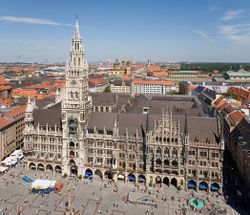
من أهم معالم ميونخ:
- المتحف الألماني (Deutsches Museum)
- قصر نيمفنبورگ (Schloß Nymphenburg)
- ميدان مارين (Marienplatz)
- كنيسة القديس بطرس (St. Peter)
- ريزيدنز (Residenz)
- المسرح الوطني (Nationaltheater)
- كنيسة السيدات (Frauenkirche)
- مكتب تسجيل الإختراعات الألماني (Deutsches Patentenamt)
- مكتب تسجيل الإختراعات الأوروبي (Europäisches Patentenamt)
- مبنى بلدية ميونخ القديم (Altes Rathaus)
- مبنى بلدية ميونخ الجديد (Neues Rathaus)
- صالة رجال الساحة (فيلدهيرن) (Feldherrnhalle)
- قصور مدينة ميونخ تتوفر مدينة ميونخ على قصور رائعة من بينها قصر نيمفنبورگ المعروف باسم إقامة منزل فيتلسباخ سابقا. ويعتبر هذا القصر من معالم المدينة الأكثر زيارة على مدار العام. ومما يثير الإنتباه عند هذا القصر هو حديقته الواسعة بما تضمه من مجاري مائية وبحيرات صغيرة وأجحار خفية.
ويوجد في الضاحية الشمالية من مدينة ميونخ قصر شليسهايم المزخرف الذي يعتبر تعبيرا لنمط من الحياة تسوده الأناقة والترف. وقد تم بناء هذا المقر الصيفي لأهل فيتلسباخ في القرن 18.
قصر شليسهايم وقريبا من الأوبرا في وسط المدينة توجد إقامة مدينة ميونخ التي استغرقت أشغال ترميمها وبنائها وإعادة بنائها خمسمائة عاما. وتعتبر هذه الإقامة مجمعا رائعا من البنايات المنتمية إلى أكبر القصور الأوربية والمحتوبة على متحف للنفائس يثير الإعجاب.
الاقتصاد والبنية التحتية



Munich has the strongest economy of any German city according to a study[37] and the lowest unemployment rate (5.4% in July 2020) of any German city of more than a million people (the others being Berlin, Hamburg and Cologne).[38][39] Munich ranks third on the list of German cities by gross domestic product (GDP). In addition, it is one of the most attractive business locations in Germany.[37] The city is also the economic centre of southern Germany. Munich topped the ranking of the magazine Capital in February 2005 for the economic prospects between 2002 and 2011 in 60 German cities.
Munich is a financial center and global city that holds the headquarters of many companies. This includes more companies listed by the DAX than any other German city, as well as the German or European headquarters of many foreign companies such as McDonald's and Microsoft. One of the best-known newly established Munich companies is Flixbus.
الصناعة
Munich holds the headquarters of Siemens AG (electronics), BMW (car), MAN AG (truck manufacturer, engineering), MTU Aero Engines (aircraft engine manufacturer), Linde (gases) and Rohde & Schwarz (electronics). Among German cities with more than 500,000 inhabitants, purchasing power is highest in Munich (€26,648 per inhabitant) اعتبارا من 2007[تحديث].[40] In 2006, Munich blue-collar workers enjoyed an average hourly wage of €18.62 (ca. $20).[41]
The breakdown by cities proper (not metropolitan areas) of Global 500 cities listed Munich in 8th position in 2009.[42] Munich is also a centre for biotechnology, software and other service industries. Furthermore, Munich is the home of the headquarters of many other large companies such as the injection moulding machine manufacturer Krauss-Maffei, the camera and lighting manufacturer Arri, the semiconductor firm Infineon Technologies (headquartered in the suburban town of Neubiberg), lighting giant Osram, as well as the German or European headquarters of many foreign companies such as Microsoft.
التمويل
Munich has significance as a financial centre (second only to Frankfurt), being home of HypoVereinsbank and the Bayerische Landesbank. It outranks Frankfurt though as home of insurance companies such as Allianz (insurance) and Munich Re (re-insurance).[43]
الإعلام
Munich is the largest publishing city in Europe[44] and home to the Süddeutsche Zeitung, one of Germany's biggest daily newspapers. The city is also the location of the programming headquarters of Germany's largest public broadcasting network, ARD, while the largest commercial network, Pro7-Sat1 Media AG, is headquartered in the suburb of Unterföhring. The headquarters of the German branch of Random House, the world's largest publishing house, and of Burda publishing group are also in Munich.
The Bavaria Film Studios are located in the suburb of Grünwald. They are one of Europe's biggest film production studios.[45]
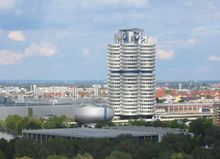
ميونخ هي أحد مراكز الاقتصاد الألماني وخاصة في مجالات البرمجيات والصناعة والبيوتكنلوجيا. حسب إحدى الدراسات التي قامت بها مجلات اقتصادية ألمانية مختصة، فإن ميونخ تعد أحد أفضل الأماكن الاقتصادية وأسرعها نموا في ألمانيا. المدينة هي مقر أكبر شركة تأمين في العالم شركة أليانز، ومقر كل من الشركات التالية:
- بي إم في (BMW): شركة سيارات
- مان (MAN): مصانع سيارات وشاحنات
- إم تي أو (MTU) : صناعة محركات الطائرات
- سيمنز (Siemens) : كهربائيات وآلات
- مايكروسوفت ألمانيا (Microsoft Deutschland) : برمجيات
- ماكدونالدز ألمانيا (McDonalds Deutschland) : سلسة مطاعم وجبات سريعة يتبعها 1264 مطعم في ألمانيا وما مجموعه 850 مليون زائر سنويا
- إيدز (EADS) : صناعات جوية وفضائية
- بنك هيبو فيرآين (HypoVerein Bank) : بنك ألماني رئيسي
- ايون (EON) : شركة طاقة
- اوسرام (OSRAM) : كهربائيات
المواصلات
افتتح مطار فرانز يوسف شتراوس ميونخ الدولي في 1992 على بعد 29 كم من المدينة. استعمله عام 2004 حوالي 27 مليون مسافر، ليكون بذلك ثاني أكبر مطار في ألمانيا وثامن أكبر مطار في أوروبا. تتخذ لوفتانزا من المطار كمركز ثاني لها ولصيانة طائراتها بعد فرانكفورت. ترتبط ميونخ من خلال محطات القطار الرئيسية فيها بشبكة القطارات الألمانية. أهم هذه المحطات هي: محطة ميونخ للقطارات الرئيسية، محطة ميونخ الشرقية، ميونخ-باسينگ و محطة رانگير-ميونخ الشمالية. هناك ثلاثة أنواع رئيسية من شبكة القطارات الداخلية في المدينة: اس-بان (S-Bahn) الذي تملكه شركة القطارات الألمانية (Deutsche Bahn)، أو-بان (U-Bahn) والترام (Straßenbahn) الذان تملكهما شركة مواصلات ميونخ. هناك ما مجموعه 10 خطوط اس-بان، 8 خطوط أو-بان و 12 خط ترام. يبلغ طول شبكة الأو-بان ما مجموعه 94,6 كم، منها 80,4 كم تحت الأرض. شركة مواصلات ميونخ تنقل 1,5 مليون مسافر يوميا.
التعليم
هناك عدد من الجامعات والمعاهد العالية والكليات في ميونخ، أهمها:
- جامعة لودڤيگ-ماكسميليان ميونخ (Ludwig-Maximilians-Universität München): تأسست عام 1472.
- جامعة ميونخ التقنية (Technische Universität München): تأسست عام 1868.
- المعهد العالي للسياسة ميونخ (Hochschule für Politik München): تأسس عام 1950.
- جامعة القوات المسلحة ميونخ (Universität der Bundeswehr München): تأسست عام 1973.
- المعهد العالي للموسيقى والمسرح ميونخ (Hochschule für Musik und Theater München) : تأسس عام 1830.
- المعهد العالي للتلفزيون والفيلم ميونخ (Hochschule für Fernsehen und Film München): تأسس عام 1966.
- أكاديمية الفنون الجميلة ميونخ (Akademie der Bildenden Künste München): تأسست عام 1808.
- المعهد العالي للفلسفة ميونخ (Hochschule für Philosophie München): تأسس عام 1925.
- كلية ميونخ التقنية (Fachhochschule München): تأسست عام 1971.
- كلية الاقتصاد والادارة (Fachhochschule für Oekonomie & Management)
- جمعية ماكس پلانك
التخصصات في الطهي
المدن الشقيقة

 إدنبره، المملكة المتحدة (since 1954) [47]
إدنبره، المملكة المتحدة (since 1954) [47] ڤيرونا، إيطاليا (since 1960)
ڤيرونا، إيطاليا (since 1960) بوردو, فرنسا (منذ 30 May 1964)
بوردو, فرنسا (منذ 30 May 1964) ساپورو, اليابان (since 1972)
ساپورو, اليابان (since 1972) سنسناتي، اوهايو، الولايات المتحدة (since 18 September 1989)
سنسناتي، اوهايو، الولايات المتحدة (since 18 September 1989) كييڤ, اوكرانيا (since 6 October 1989)
كييڤ, اوكرانيا (since 6 October 1989) هرارى، زيمبابوى (since April 1996)
هرارى، زيمبابوى (since April 1996) حيدر أباد، الهند (منذ يونيو 2005)
حيدر أباد، الهند (منذ يونيو 2005)- بئر سبع, إسرائيل (2021)
المصادر
- كتاب ألمانيا من دار نشر بدكر أليانز، الطبعة الخامسة 2000 باللغة الألمانية، ISBN 3-89525-976-4
ملاحظات
- ^ Two meteorological stations are responsible for the climatological data so that they are interpolated.[25]
- ^ It ist a local party, founded in 1989 to support the queer community. It is represented in some Munich borough coucils since 1990 (with its stronghold in the borough of Ludwigsvorstadt-Isarvorstadt) and in the city council continuously since 1996.
الهامش
- ^ "Daten und Fakten aus der Metropolregion München" [Data and facts about the Munich Metropolitan Region]. Europäische Metropolregion München e.V. Archived from the original on 20 June 2019. Retrieved 20 June 2019.
- ^ "Fortschreibung des Bevölkerungsstandes". Bayerisches Landesamt für Statistik und Datenverarbeitung (in German). July 2019.
{{cite web}}: CS1 maint: unrecognized language (link) - ^ "The Munich Metropolitan Region" (in الألمانية). Europäische Metropolregion München e.V. Archived from the original on 31 May 2017. Retrieved 17 April 2017.
- ^ Englund, Peter (1993). Ofredsår. Stockholm: Atlantis.
- ^ "Quality of Living City Rankings". Business Insider. Retrieved 19 March 2023.
- ^ "Munich Named The Most Livable City In The World". Forbes. 25 June 2018. Retrieved 2 July 2018.
- ^ Wille, Robin (2021-07-15). "Immobilien: Das sind die 10 teuersten Städte in Deutschland". Business Insider (in الألمانية). Archived from the original on 16 April 2022. Retrieved 2022-04-16.
- ^ "Die 10 teuersten Städte Deutschlands 2020". www.haus.de (in الألمانية). Archived from the original on 18 April 2022. Retrieved 2022-04-16.
- ^ "Bevölkerung am 31.12.2021 nach Migrationshintergrund in den Stadtbezirken" [Population on 31.12.2021 by migration background in the city districts] (PDF). Statistisches Amt München. 21 January 2022. Retrieved 8 April 2023.
- ^ Boytchev, Hristio (2018). "A European heavyweight". Nature. 563 (7729): S14–S15. Bibcode:2018Natur.563S..14B. doi:10.1038/d41586-018-07208-0. PMID 30382228.
- ^ "Munich Travel Tourism Munich". muenchen.de. Archived from the original on 14 February 2016. Retrieved 12 February 2016.
- ^ John Everett-Heath (2019). The Concise Dictionary of World Place-Names. OUP Oxford. ISBN 9780192602541.
- ^ River Culture: Life as a dance to the rhythm of the waters. Bernan Associates UNESCO. 2023. p. 616. ISBN 9789231005404.
- ^ "Feldkirchen: Bronzezeit-Funde auf dem Bauma-Parkplatz". 23 August 2022.
- ^ Klaus Schwarz: Atlas der spätkeltischen Viereckschanzen Bayerns – Pläne und Karten. München, 1959
- ^ Wolfgang Krämer: Geschichte der Gemeinde Gauting einschließlich der Hofmarken Fußberg und Königswiesen nebst Grubmühle, Reismühle und Gemeinde Stockdorf sowie der Schwaigen Kreuzing und Pentenried. Selbstverlag der Gemeinde Gauting, 1949.
- ^ Willibald Karl (Hrsg.): Dörfer auf dem Ziegelland. Daglfing-Denning-Englschalking-Johanneskirchen-Zamdorf. Buchendorfer, München 2002, ISBN 978-3-934036-90-1.
- ^ "Sensationsfund: Die Überreste der ersten Pasinger". 17 June 2016. Archived from the original on 2021-10-21.
- ^ "Archäologie in München – Archäologische Staatssammlung München". Archived from the original on 2021-10-21.
- ^ Bernd Meier, Ludwig Maile: Heilig Kreuz Fröttmaning 815–1990. Kirchenverwaltung und Pfarrgemeinderat St. Albert, München 1990, S. 13–15.
- ^ Andrew L. Thomas (2010). A House Divided: Wittelsbach Confessional Court Cultures in the Holy Roman Empire, C. 1550–1650. BRILL. p. 88. ISBN 9789004183704.
- ^ Andrew L. Thomas (2010). A House Divided: Wittelsbach Confessional Court Cultures in the Holy Roman Empire, C. 1550–1650. BRILL. p. 90. ISBN 9789004183704.
- ^ Andrew L. Thomas (2010). A House Divided: Wittelsbach Confessional Court Cultures in the Holy Roman Empire, C. 1550–1650. BRILL. p. 88. ISBN 9789004183704.
- ^ Antony Wood; Ruba Salib, eds. (2013). Natural Ventilation in High-rise Office Buildings. Routledge. p. 93. ISBN 9780415509589.
- ^ Stationsgeschichte der Messgeräte[dead link], DWD. Retrieved 12 February 2019.
- ^ "CDC (Climate Data Center)". DWD. Archived from the original on 14 January 2017. Retrieved 2 May 2016.
- ^ "Monatsauswertung". sklima.de (in الألمانية). SKlima. Archived from the original on 7 June 2016. Retrieved 2 May 2016. |date=May 2016
- ^ "Anpassung an den Klimawandel". Landeshauptstadt München Redaktion.
- ^ "Die ausländische Bevölkerung nach der Staatsangehörigkeit 2017" (PDF). Archived (PDF) from the original on 19 June 2018. Retrieved 19 June 2018.
- ^ "Kroaten in München - Die zweite Hauptstadt". sueddeutsche.de (in الألمانية). 17 May 2010. Retrieved 2023-07-24.
- ^ "Die ausländische Bevölkerung nach der Staatsangehörigkeit 2020" (PDF). Archived (PDF) from the original on 19 June 2018. Retrieved 19 June 2018.
- ^ "Landeshauptstadt München: Bevölkerungsbestand – Aktuelle Jahreszahlen: Die Bevölkerung in den Stadtbezirken nach ausgewählten Konfessionen am 31.12.2017" (PDF). muenchen.de. Archived (PDF) from the original on 24 March 2018. Retrieved 21 March 2018.
- ^ "Bevölkerung im regionalen Vergleich nach Religion (ausführlich) in %". Statistische Ämter des Bundes und der Länder. 2014. Archived from the original on 21 June 2013. Retrieved 7 May 2018.
- ^ "Extremisten sind eine kleine Minderheit". Süddeutsche Zeitung. 2014. Archived from the original on 28 August 2019. Retrieved 28 August 2019.
- ^ "Weltkongress der Uiguren - München". www.sueddeutsche.de (in الألمانية). 25 November 2019. Retrieved 2023-07-24.
- ^ "Germany: München (Boroughs and Quarters) - Population Statistics, Charts and Map". citypopulation.de.
- ^ أ ب "Study conducted by INSM (New Social Market Economy Initiative) and WirtschaftsWoche magazine". Icm-muenchen.de. Archived from the original on 19 June 2012. Retrieved 25 July 2012.
- ^ "Statistik der BA". statistik.arbeitsagentur.de. Archived from the original on 28 February 2014. Retrieved 11 August 2020.
- ^ Artikel empfehlen (27 September 2010). "Endlich amtlich: Köln ist Millionenstadt". Koeln.de. Archived from the original on 1 October 2011. Retrieved 15 September 2011.
- ^ "In Hesse the purchasing power is highest in Germany – CyberPress". Just4business.eu. Archived from the original on 16 September 2011. Retrieved 25 July 2012.
- ^ Landeshauptstadt München, Direktorium, Statistisches Amt: Statistisches Jahrbuch 2007, page 206 (Statistical Yearbook of the City of Munich 2007) http://currency.wiki/18-62eur-usd[dead link] "EUR to USD – Exchange Rate – Euro to Dollar Conversion – Live Rates". Retrieved 17 March 2020.[dead link]
- ^ "Global 500 2008: Cities". Money.cnn.com. 21 July 2008. Archived from the original on 29 May 2010. Retrieved 25 July 2012.
- ^ "Insurance – Munich Financial Centre Initiative". www.fpmi.de (in الإنجليزية). Archived from the original on 27 February 2018. Retrieved 27 February 2018.
- ^ "Munich Literature House: About Us". Archived from the original on 4 April 2003. Retrieved 17 February 2008.
- ^ "Bavaria Film GmbH: Company Start". Bavaria-film.de. Archived from the original on 29 May 2012. Retrieved 25 July 2012.
- ^ "Partnerstädte". muenchen.de (in الألمانية). Munich. Archived from the original on 2021-10-21. Retrieved 27 February 2021.
- ^ "Edinburgh - Twin and Partner Cities". © 2008 The City of Edinburgh Council, City Chambers, High Street, Edinburgh, EH1 1YJ Scotland. Retrieved 2008-12-21.
وصلات خارجية
- Pages using gadget WikiMiniAtlas
- CS1 الألمانية-language sources (de)
- Articles with dead external links from September 2019
- Articles with dead external links from January 2021
- Articles with dead external links from March 2020
- Short description is different from Wikidata
- Articles containing ألمانية-language text
- Articles containing باڤارية-language text
- Pages using multiple image with auto scaled images
- Coordinates on Wikidata
- المدن in Bavaria
- Pages using Lang-xx templates
- Articles with hatnote templates targeting a nonexistent page
- Articles with unsourced statements from January 2023
- Wikipedia articles in need of updating from June 2023
- All Wikipedia articles in need of updating
- مقالات فيها عبارات متقادمة منذ 2007
- جميع المقالات التي فيها عبارات متقادمة
- المدن المضيفة للألعاب الاولمبية الصيفية
- ميونخ
- عواصم ولايات ألمانية
- مدن مضيفة للألعاب الاولمپية الصيفية
- جاليات تركية خارج تركيا
- مدن ألمانيا
- صفحات مع الخرائط
















